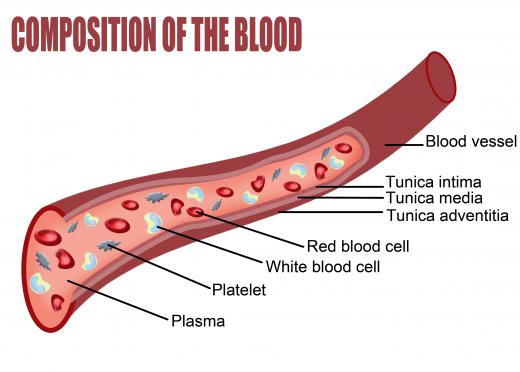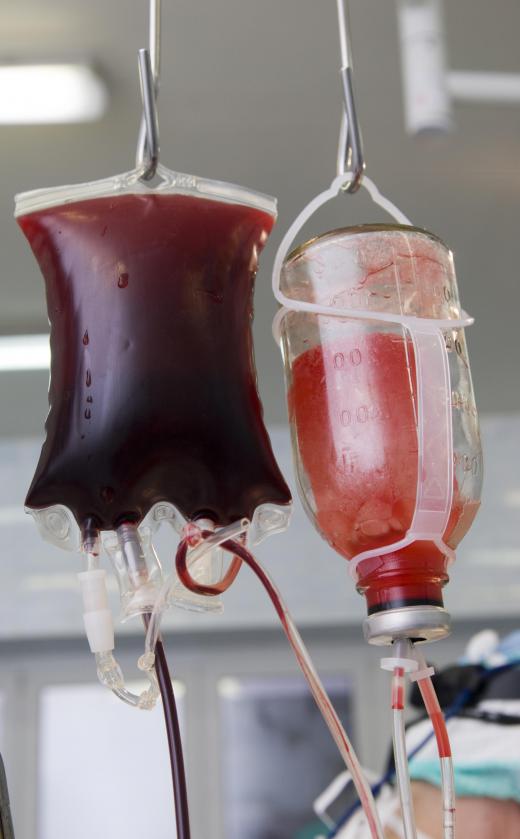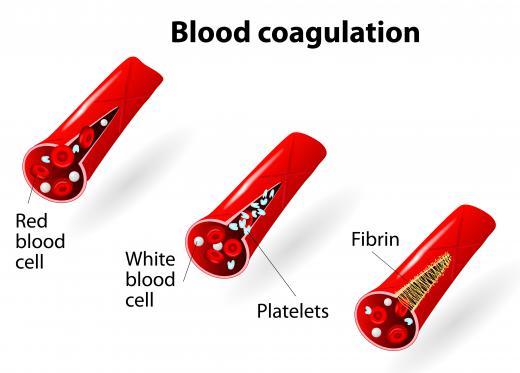What Is a Platelet Plug?
Hemostasis is an involuntary bodily function intended to stop bleeding. It occurs in human and animal bodies when a cut is made in the skin or a blood vessel. After vascular spasms and vasoconstriction reduce the flow of blood within the damaged vessel, a platelet plug is the second step of hemostasis. Platelets — cell fragments lacking a nucleus but containing their own deoxyribonucleic acid (DNA) — that travel within the blood go through three steps to plug any holes or cuts. This plug occurs after and is more complex than vascular spasms and vasoconstriction; blood clotting follows the plug in hemostasis to finish the process.
The first step associated with the platelet plug is called platelet adhesion. After the blood vessel has been damaged or punctured, platelets detect the damaged cells. Nearby platelets will adhere to any open surfaces, creating a small clot to keep additional damage from occurring. This is the starting point of the platelet plug.

After adhering to the damaged area, the platelets undergo a change known as platelet release reaction. The platelets grow tendrils and contact other nearby platelets, forming a wall. Once all the nearby platelets are connected, they open up and release packages. Every platelet package contains two types of contents: alpha granules and dense granules.

Alpha granules are used to heal the immediate area. They contain clotting and growth factors to help new blood grow and to seal the damaged area. The second type of granule, dense granules, contains chemicals that call other platelets. This helps to make the platelet clot more effective.
In the last stage of the platelet plug, platelet aggregation, the platelets become sticky. This causes new platelets called by the dense granules to stick to the nearby platelets. By becoming sticky, the platelets are able to fully seal any damage in the blood vessel, and the platelet plug is complete.

While the platelet plug is useful in stopping bleeding and blood vessel damage, it does not occur alone. By itself, the plug would be unable to stop bleeding completely, and movement may damage the plug. Blood clotting occurs next and is the most complex hemostatic activity, turning the blood into a gel and attempting to stop any blood from leaving the body. Unless the wound is severe, this hemostatic activity should be enough to close and heal a common cut without the need for stitches or other medical procedures.
AS FEATURED ON:
AS FEATURED ON:
















Discussion Comments
@fBoyle-- Aspirin prevents platelets from binding together. So they will interfere with the formation of a platelet plug as well as blood clotting. This is why aspirin is recommended for people who are at risk for heart attacks.
There are also health conditions and deficiencies that can prevent platelets from forming a plug. It could be because of a low number of platelets or a deficiency in fibrinogen protein that binds the platelets together.
How does aspirin prevent the formation of a platelet plug?
I just accidentally cut my hand. It's a small cut and the bleeding stopped in seconds. I remember learning about blood clotting in class but I don't remember anything about platelet plug formation. If I understand correctly, platelet plugs are what we see occur when the bleeding stops on our skin right?
Do we see blood clotting at all? That happens underneath the plug right? So we don't see it?
Post your comments